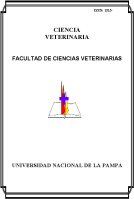Detección de inmunoglobulina G en sueros, tejidos y extractos placentarios porcinos
Keywords:
Swine, PlacentaAbstract
Studies have proved that humoral immune response is involved in swine pregnancy. Pigs have IgG, IgM, IgA and IgE. Swine IgG subclasses have their greatest similarity with those of the human, except for the near absence of hinge region variation. The goal of this study was to determine the presence of IgG in porcine serum, tissue and placental extracts. In 15 animals' serum, by means of electrophoresis proteinegramma in strips of cellulose acetate, the average values were empty pig (n=5) 23mg/ml; 30 days (n=5) 19.5mg/ml; and 91 days of gestation (n=5) 16.8 mg/ml. By radial immunodifusion (using calibrated commercial human kits to determine the concentration of human IgG), the average values in porcine serum (n=15) were non-pregnant swine 26.88 mg/ml; 30 days 29.88 mg/ml; 91 days of gestation 19.24 mg/ml. In placental extracts, Porcine Empty Uterus Homogenates: 3.40 mg/ml; Porcine Placenta Homogenates (PPHo) 30 days: 1.81mg/ml; PPHo 91 days: 1.50 mg/ml. and in Porcine Placenta Conditioned Medium (PPCM) 30 days: 2.11 mg/ml and PPCM 91 days of gestation: 1.20 mg/ml. By direct immunofluorescencia, using one antibody (human anti-IgG conjugated with FITC), we observed: fluorescence (++) on placental tissues at term, in the foetal chorionics villi in contact with the uterine lumen. Probably these antibodies belong to the type of protective and asymmetric immunoglobulin G antibodies described in woman and mouseDownloads
Downloads
Published
How to Cite
Issue
Section
License
Al momento de enviar sus contribuciones, los colaboradores deberán declarar , de manera fehaciente, que poseen el permiso del archivo o repositorio donde se obtuvieron los documentos que se anexan al trabajo, cualquiera sea su formato (manuscritos inéditos, imágenes, archivos audiovisuales, etc.), permiso que los autoriza a publicarlos y reproducirlos, liberando a la revista y sus editores de toda responsabilidad o reclamo de terceros , los autores deben adherir a la licencia Creative Commons denominada “Atribución - No Comercial CC BY-NC-SA”, mediante la cual el autor permite copiar, reproducir, distribuir, comunicar públicamente la obra y generar obras derivadas, siempre y cuando se cite y reconozca al autor original. No se permite, sin embargo, utilizar la obra con fines comerciales.



4.png)


7.png)



